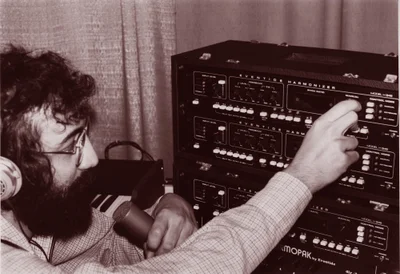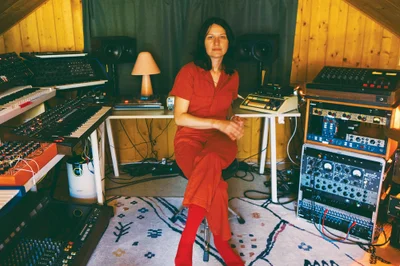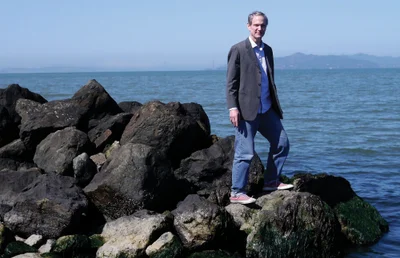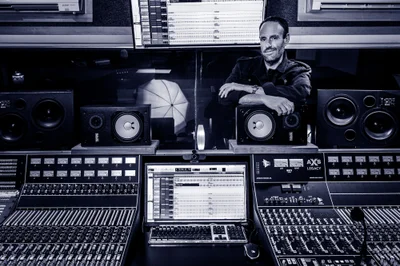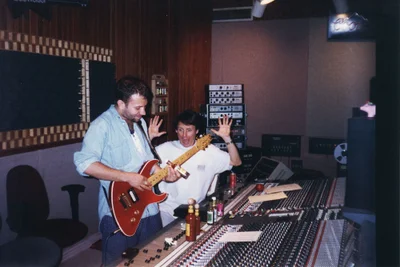I've tried your mics and really like them. How did you get started?
Bob: We wanted to provide a tool, which actually turned out to be an instrument. Our first microphone, the Studio Vocalist, came about because I was very interested in the human voice — it has a lot of complex qualities to it. And it wasn't sounding too good on some of the CDs of the '80s. I thought it was just me. I thought, "I just don't like vocals anymore, but I liked them back when I was listening to vinyl." It turned out that a lot of people shared the same perception that vocals, especially the "tizz" in a vocal, could really get to you after a while. I started looking into what was going on in the field that was designed to mitigate that. I saw that everybody was going on the quest for the ever-better microphone, going up the scale [to] the $5,000 and $10,000 condensers. So I looked into the physics. I asked, "Why does it sound that way?" We made a discovery: When you activate a diaphragm at very high frequencies, air molecules agitate behind the diaphragm. And there are lateral modes that move across the face of the diaphragm that contribute to the "tizz" sound. I thought, "Well, I guess we're not going to be making any condenser microphones," because the condenser microphone represents a hard surface that the sound works against, and the ribbon microphone is more like a heart valve that moves with the flow — more like vocal chords themselves, which are designed to work with the air and couple to the air. If you've ever noticed seaweed just right at the shore, it just wants to follow the motion of the wave. That's the way that the ribbon likes to perform. We look to nature [for design ideas] because we're dealing with the natural body. We're dealing with the creative output of human beings. It's an organic thing that that has a natural component to it. What is naturally lightweight and is designed to work with air? You can look at a leaf, or a blade of grass or you could look at a fly's wing. This is a potential model for a type of transducer. So, we started looking at ribbons as sort of the main feature, an opportunity. We saw that there had been a lot of interest in that area. We asked, "If ribbon mics are so great, why aren't people using them?" The answer was that they were fragile, they had low output and they sounded dark. What if it was robust, had a higher output and a curve that matched what you wanted to do — like a vocal curve with a bit of a rise to it? A rise in response so that the vocal stands out. We went around and looked at the old and new ribbon microphones and saw that they all required tons of gain on the preamps. So we emulated the output level of a [Shure] SM57, without having to add an [internal] amplifier and without adding noise. That was one of the most difficult parts of the development. But it was a part of the development that I knew we could do, because we had worked with really, really tiny ultrasound transducers. That was the problem with those — getting enough signal so you could image the human heart. Then we were left with tone. "What are the tone options?" Some wanted a really rolled-off response — that's what the Proscenium is. It's intentionally designed to have that old-school, ribbon response like an RCA 44. We did the Proscenium and the Soundstage Image simultaneously. We could go darker and smoother, and we could go in the middle so it was accurate. We put the Soundstage Image in the middle for people who wanted something that was useful for a variety of things and also good at a distance. Then we added one more mic, the SPLx custom-build mic. If you have a lisp or you have a real hissy sibilance or a nasal sound, we can work directly with the artist. The SPLx can be made for extremely loud sound sources, a true 150-160 db. The SPLx name implies "loud", but the SPLx can be any custom microphone — we can roll it off, we can give you a tilt if you want. We can do a lot of things with it.
What's the story with the Naked Eye?
Bob: I play the Shakuhachi, [a traditional Japanese end blown flute]. I started playing around, recording it, and I found that I needed an accurate [mic] position because the sound distribution around the instrument is very complex. I started thinking about what I would do if I had my own favorite little mic. The other part was, how can we scale down what we're doing and provide the two most popular voices that we have in our microphones? The Vocalist is voiced for vocals and the Proscenium is voiced for a dark, rolled-off kind of sound. We approximated those two voices in the Naked Eye and made it asymmetric. You use either side for its respective voice — it's two mics in one. It's a figure- eight design. We incorporated a very simple, versatile mount with a lot of swing to it so you could dial in the rotary angle, rotate it on its axis and then lock it into place, generally with one hand. We knew people who loved our mics that owned inexpensive Chinese ribbon mics. They could hear the difference, but weren't quite ready to buy a mic from us. It's a big difference in money. We started thinking about how to cut costs. The advice we got was, "You've got to make them in China." I said, "Uh-uh, we're not going to do that." I need to have control of the quality and just don't want to go there. We're a "made in the USA" company. We reduced the number of processing steps and then we designed the Naked Eye so that it could be made in larger numbers. The batches are inherently larger, instead of being made one-by-one as our larger ribbon mics are. We offer them at a lower price and give people a break, and that seems right to a lot of people.
Who's using your mics?
Bob: We don't give out client lists, but Anthony Resta has been a contributor to the development. He's very insightful and will tell you when something isn't right. He loves the mics — he used them on Perry Farrell's new project and owns all of our mics. We call him a rabid customer. He puts the Studio Vocalist in front of virtually every singer. We're popular in Europe and the United Kingdom, and pretty happy about that.
I'm interested in the partnership. How does that work?
Hugh: It's a collaboration. Bob and I have a lot of overlapping skill sets. I'm not the only one who gets in there and gets his hands dirty putting these things together and making parts. Bob has some strengths that I don't have, and vice versa, and that allows us to dig in and understand what each other is doing. We both come from a very precise industry and it's our ultimate goal to have very precise instruments — which is what we've executed here. You'll find a level of precision that just doesn't exist [elsewhere in the market]. If you look at the exact way we dimension things, the tolerances that we put on things, you know that we are getting a very repetitive result. You build three or four mics, put them on the test bench and the curves are the same.
The weight alone is enough to blow you away!
Hugh: Maybe a little overkill!
What made you decide to go into business together?
Hugh: Bob and I had worked together for years at Boston Scientific. I worked for him when he was running the ultrasound group there. I think we appreciate each other's ability and how we each approach problems. We relate well on that level. We can set an end-goal and say we want to make this microphone, and know what the steps are that we need to take to get there. And, in this particular industry, it was an easier entrance into the marketplace than it would be for a medical device. That being said, we still apply all of the principles we've learned in the medical industry while building our mics.
What was it like to machine the first one? Did you know how to go after the sound you wanted? Were there any failures?
Hugh: When you are looking at designing something, you sit down, go back and forth, this idea, that idea, put a few things down on paper. But where the rubber hits the road is when you actually start constructing the thing. And typically, how I've approached design my whole career is: get a quick sketch, talk it about and just put the thing together. Now you've got a starting point, and you work from there. When we started off we were looking at the guts, the heart of the device, the motor unit. Obviously, we've tweaked and refined from there, but the basic concept is the same. There were a number of iterations that we went through to get to that point. We are very good about keeping notes and understanding where we started. We had a good solid foundation in our technology. That's the way we've always operated.
Any final thoughts?
Bob: We've never had to re-ribbon one of our mics. We've been around for a while, we've got a lot of mics out in the field — they're out there and they're not just lying around. We have a very low failure rate and a lifetime warranty (and a three year warranty on Naked Eye) and that's a no worry situation.

